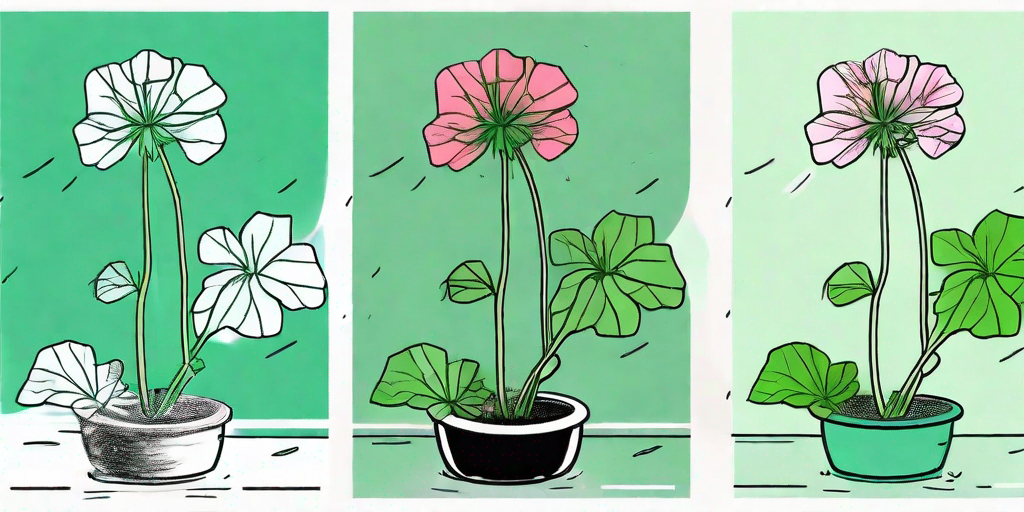
Ah, geraniums! Those vibrant, vivacious, and sometimes vexing flowers that grace our gardens with their presence. But what happens when your geraniums start to look a little...well, dead? Fear not! This guide will walk you through the process of reviving your deadhead geraniums and bringing them back to life. So, grab your gardening gloves and let's get started!
Understanding Your Geraniums
Before we dive into the nitty-gritty of geranium revival, it's important to understand a bit about these plants. Geraniums are perennial plants, which means they can live for several years if properly cared for. They are known for their bright, colorful flowers and their fragrant, aromatic leaves.
However, like all living things, geraniums can experience periods of decline. This is often due to a lack of proper care, environmental factors, or simply the natural life cycle of the plant. But don't despair! With a little TLC, your geraniums can be revived and restored to their former glory.
Why Do Geraniums Become Deadheads?
Deadheading is a term used in gardening to describe the removal of faded or dead flowers from plants. This is done to encourage the plant to focus its energy on producing new flowers, rather than maintaining the old ones. However, if your geraniums are not properly deadheaded, they can become weak and unhealthy.
There are several reasons why your geraniums may become deadheads. These include lack of water, insufficient sunlight, poor soil quality, and disease or pest infestation. By identifying the cause of your geraniums' decline, you can take steps to address the issue and revive your plants.
Reviving Your Deadhead Geraniums
Now that we've covered the basics of geranium care, let's get down to business. Here's how to bring your deadhead geraniums back to life.
Step 1: Assess the Situation
First, take a good look at your geraniums. Are the leaves yellow or brown? Are the flowers faded or wilted? These are signs that your geraniums are in distress. Make a note of any symptoms you observe, as this will help you determine the best course of action.
Next, check the soil. Is it dry and crumbly, or wet and soggy? Geraniums prefer well-drained soil, so if the soil is too dry or too wet, this could be contributing to your plants' decline.
Step 2: Provide Proper Care
Once you've assessed the situation, it's time to take action. Start by watering your geraniums thoroughly. They prefer to be watered deeply, but infrequently, so make sure the soil is thoroughly soaked, then allow it to dry out before watering again.
Next, make sure your geraniums are getting enough sunlight. They need at least six hours of sunlight each day, so if they're in a shady spot, consider moving them to a sunnier location.
Step 3: Deadhead the Geraniums
Now, it's time to deadhead your geraniums. This involves removing the faded or dead flowers to encourage new growth. To do this, simply pinch or cut off the flower at the base of the stem. Be sure to remove the entire flower, including the stem, as this will encourage the plant to produce new blooms.
After deadheading, give your geraniums a good feed. Use a balanced, water-soluble fertilizer, and follow the package instructions for application rates. This will provide your plants with the nutrients they need to produce new flowers.
Preventing Future Deadheads
Reviving your deadhead geraniums is one thing, but preventing future deadheads is another. Here are some tips to keep your geraniums healthy and vibrant.
Water Wisely
As mentioned earlier, geraniums prefer to be watered deeply but infrequently. Overwatering can lead to root rot, while underwatering can cause the plant to become dehydrated and weak. To ensure your geraniums get the right amount of water, check the soil regularly. It should be moist, but not soggy.
Feed Regularly
Geraniums are heavy feeders, which means they need a lot of nutrients to grow and bloom. To keep your geraniums well-fed, apply a balanced, water-soluble fertilizer every two weeks during the growing season.
Provide Plenty of Sunlight
Geraniums love the sun, so make sure they get plenty of it. A minimum of six hours of sunlight each day is ideal. If your geraniums are in a shady spot, consider moving them to a sunnier location.
FAQs
Why are my geraniums not blooming?
There could be several reasons why your geraniums are not blooming. These include insufficient sunlight, lack of nutrients, overwatering, or disease or pest infestation. If your geraniums are not blooming, try moving them to a sunnier location, feeding them with a balanced fertilizer, and checking for signs of disease or pests.
Can deadhead geraniums be revived?
Absolutely! With a little TLC, deadhead geraniums can be revived and restored to their former glory. The key is to provide proper care, including watering deeply but infrequently, feeding regularly with a balanced fertilizer, and ensuring plenty of sunlight.
How often should I deadhead my geraniums?
You should deadhead your geraniums as soon as the flowers start to fade or die. This will encourage the plant to produce new blooms and keep your geraniums looking fresh and vibrant.
Conclusion
So there you have it, folks! With a little bit of knowledge, some elbow grease, and a dash of love, you can revive your deadhead geraniums and bring them back to life. Remember, gardening is not just about having the greenest thumb or the most beautiful flowers. It's about the joy of nurturing life, the satisfaction of seeing your plants thrive, and the sheer delight of witnessing nature's miracles right in your own backyard. So go ahead, roll up your sleeves, and bring those geraniums back to life. Happy gardening!















